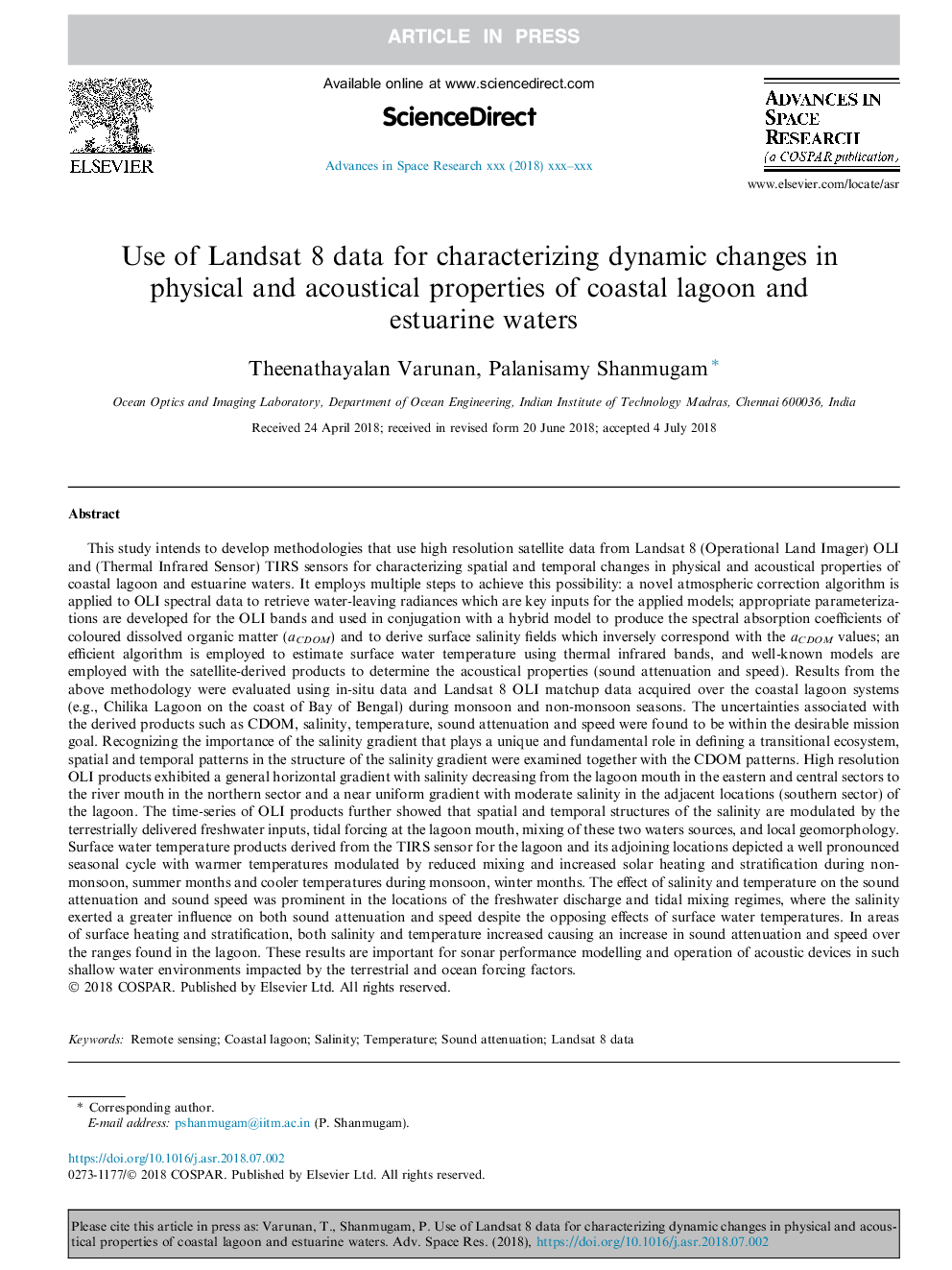| کد مقاله | کد نشریه | سال انتشار | مقاله انگلیسی | نسخه تمام متن |
|---|---|---|---|---|
| 11019676 | 1717623 | 2018 | 25 صفحه PDF | دانلود رایگان |
عنوان انگلیسی مقاله ISI
Use of Landsat 8 data for characterizing dynamic changes in physical and acoustical properties of coastal lagoon and estuarine waters
ترجمه فارسی عنوان
استفاده از داده های لندست 8 برای توصیف تغییرات پویا در ویژگی های فیزیکی و آکوستیکی دریاچه ساحلی و آب های استوایی
دانلود مقاله + سفارش ترجمه
دانلود مقاله ISI انگلیسی
رایگان برای ایرانیان
کلمات کلیدی
سنجش از دور، تالاب ساحلی، شوری درجه حرارت، تضعیف صدا، اطلاعات لندست 8،
موضوعات مرتبط
مهندسی و علوم پایه
علوم زمین و سیارات
علوم فضا و نجوم
چکیده انگلیسی
This study intends to develop methodologies that use high resolution satellite data from Landsat 8 (Operational Land Imager) OLI and (Thermal Infrared Sensor) TIRS sensors for characterizing spatial and temporal changes in physical and acoustical properties of coastal lagoon and estuarine waters. It employs multiple steps to achieve this possibility: a novel atmospheric correction algorithm is applied to OLI spectral data to retrieve water-leaving radiances which are key inputs for the applied models; appropriate parameterizations are developed for the OLI bands and used in conjugation with a hybrid model to produce the spectral absorption coefficients of coloured dissolved organic matter (aCDOM) and to derive surface salinity fields which inversely correspond with the aCDOM values; an efficient algorithm is employed to estimate surface water temperature using thermal infrared bands, and well-known models are employed with the satellite-derived products to determine the acoustical properties (sound attenuation and speed). Results from the above methodology were evaluated using in-situ data and Landsat 8 OLI matchup data acquired over the coastal lagoon systems (e.g., Chilika Lagoon on the coast of Bay of Bengal) during monsoon and non-monsoon seasons. The uncertainties associated with the derived products such as CDOM, salinity, temperature, sound attenuation and speed were found to be within the desirable mission goal. Recognizing the importance of the salinity gradient that plays a unique and fundamental role in defining a transitional ecosystem, spatial and temporal patterns in the structure of the salinity gradient were examined together with the CDOM patterns. High resolution OLI products exhibited a general horizontal gradient with salinity decreasing from the lagoon mouth in the eastern and central sectors to the river mouth in the northern sector and a near uniform gradient with moderate salinity in the adjacent locations (southern sector) of the lagoon. The time-series of OLI products further showed that spatial and temporal structures of the salinity are modulated by the terrestrially delivered freshwater inputs, tidal forcing at the lagoon mouth, mixing of these two waters sources, and local geomorphology. Surface water temperature products derived from the TIRS sensor for the lagoon and its adjoining locations depicted a well pronounced seasonal cycle with warmer temperatures modulated by reduced mixing and increased solar heating and stratification during non-monsoon, summer months and cooler temperatures during monsoon, winter months. The effect of salinity and temperature on the sound attenuation and sound speed was prominent in the locations of the freshwater discharge and tidal mixing regimes, where the salinity exerted a greater influence on both sound attenuation and speed despite the opposing effects of surface water temperatures. In areas of surface heating and stratification, both salinity and temperature increased causing an increase in sound attenuation and speed over the ranges found in the lagoon. These results are important for sonar performance modelling and operation of acoustic devices in such shallow water environments impacted by the terrestrial and ocean forcing factors.
ناشر
Database: Elsevier - ScienceDirect (ساینس دایرکت)
Journal: Advances in Space Research - Volume 62, Issue 9, 1 November 2018, Pages 2393-2417
Journal: Advances in Space Research - Volume 62, Issue 9, 1 November 2018, Pages 2393-2417
نویسندگان
Theenathayalan Varunan, Palanisamy Shanmugam,
